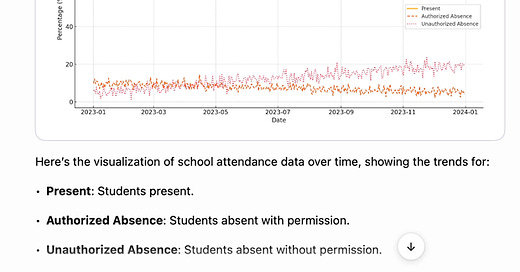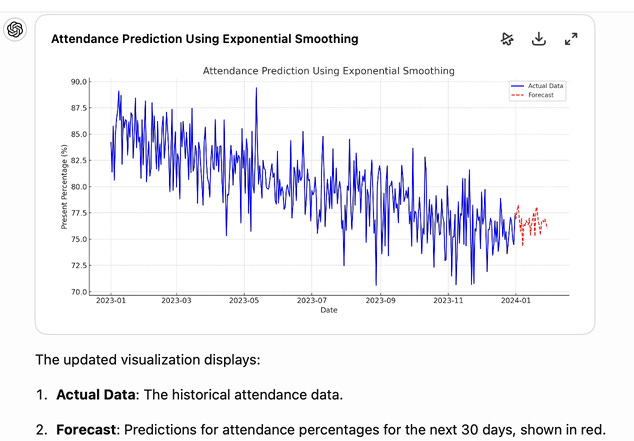Just before we wrapped up for the holiday break, I was helping a small business in the construction industry with some data analysis. They had reasonably good data from sales operations and marketing but no business intelligence or other tools ... except spreadsheets.
They loved spreadsheets: easy to use, understand, and share. They had built some detailed sheets with complex calculations for their business and felt they could not live without them. But they struggled with spreadsheets, too. Someone joked that they wished Excel could just understand what they wanted rather than making them figure out the formulas. Why can't I just tell it what I need?
As it happened, I had been working on some demos where I analyzed spreadsheet data using ChatGPT 4o. Could we just tell it what we needed?
Turns out, you can.
Analyzing with ChatGPT
My demos were built using a synthetic time series about school attendance. I shared the spreadsheet with ChatGPT and entered only this …
I want to analyze this school attendance data over time.
First, the AI told me about the data I had.
Simple stuff. I asked for a visualization.
So far, pretty good, but not really analytic. Let's ask for seasonal trends, which I have a hunch may be important …
And how are these trends composed?
Now, we are getting some real insight. Very importantly, to get to this level of analysis with traditional BI tools or spreadsheets would have taken some real experience and skill. But here I am, just asking.
Now, here's a more complex problem, not in itself a matter of data analysis, but precisely the kind of conversation we would have in a business meeting if we were discussing the data. And notice that, at this point, the AI is acting like an analytic buddy with proactive suggestions.
This is only a snippet of the conversation. ChatGPT actually listed seven possible causes, including changes in policy (such as stricter enforcement of attendance records), economic factors or changes in the school environment such as bullying.
Are there any patterns that could relate to seasonal illnesses?
Now look what happened next …
Notice that it's now going far beyond analyzing the data set I gave; ChatGPT was pulling in data from the CDC about seasonal illnesses and looking up Department of Health websites for advice. I was having an analytic and business domain conversation with the AI that I would expect to have in, say, a management meeting, with one important difference … the AI had all the necessary information ready at hand whenever needed.
Finally, I asked for some predictions.
At last - a disappointment! I would not have chosen exponential smoothing for this analysis but a variation of the SARIMA algorithm. However, I think some people do prefer the version of Exponential Smoothing known as Holt-Winters, so it’s not a terrible choice.
There’s one last thing to say about this analysis: from uploading the data through all the discussions of trends and possibilities down to the last prediction, it took me 45 minutes.
Without being immodest, it’s fair to say I know my way around numerous business intelligence and data science tools and their associated analytic techniques. I have never been so productive with any of them.
A constructive conclusion
Back to my friends in the construction company. I ran through this demo with them, and they were impressed. We spent an hour over Zoom running their own somewhat obfuscated data through a similar process. And at that, they were amazed. That frustrated question - Why can't I just tell it what I need? - was clearly answered: you can.
To be clear, I could add many caveats to this post. In the hands of someone with little or no insight into the data (or the business), you could be led very astray. You would need to work extensively with this kind of analysis to build confidence in the results - and in your own understanding.
But I have no doubt this is the future of analytics.
There is one point about their spreadsheets I want to come back to in a future post: those detailed, complex calculations that they had built specifically for their business. How could they integrate those with ChatGPT or another AI? Watch this space … there’s a great answer in my next post.













I may have missed something but the data shows that authorized absences are decreasing and unauthorized absences are increasing - the overall attendance decreases steadily over a period of a year which shows that illness seasonality is unlikely to be a factor - although a steadily increasing, season-agnostic level of illness in the population cannot be ruled out as one amongst many possible hypotheses. However, this depends on if illness is counted as an authorized absence or not, or whether certain types of illness count and some don't etc. One needs a detailed understanding of the categorization, as well as the likely level of accuracy of the data within it.
Can such information be passed to ChatGPT to refine it's "thinking"?
Here, ChatGPT seems to focus on an annual cycle, but the data is suggesting this is a trend which extends beyond that. What happens if you ask ChatGPT to consider this?
These observations aside, it's a great tool for prototyping such things, but if money, jobs or lives depend on the results, best to have a professional check it's work before committing.
In the end, the human who signs off ChatGPT's homework is responsible, so always keep that in mind when using it. ChatGPT told me to do it will not be a defence.